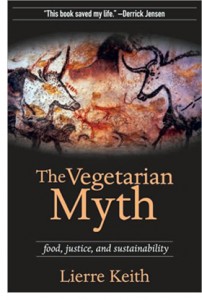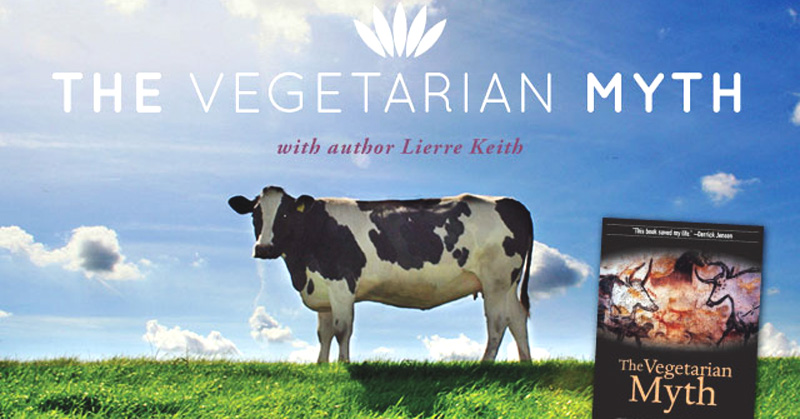Last week I wrote about my switch from vegetarianism to finding peace with being an omnivore, a process that was slow and difficult on me emotionally. Last year I was turned on to a mind-expanding booked called The Vegetarian Myth, which is an excellent read for anyone who eats – whether you’re a vegetarian, an omnivore, or any shade in between. My colleague Debra Meadow wrote a great review of this book, excerpts from which we’ve included here to give you a taste of what it’s all about. Enjoy! ~Margaret
~~~~~~~~~~~~~
 I just finished reading The Vegetarian Myth, by Lierre Keith (Flashpoint Press, 2009) and I can tell you it was not an easy book to read, forcing me to face some pretty grim facts about the direction civilization has been traveling since the dawn of agriculture, about 12,000 years ago. Having said that, I highly recommend it to anyone serious about understanding the depth and breadth of the challenges agriculture has posed on the global, national, community, individual and gut (yes, I mean “tummy”) levels.
I just finished reading The Vegetarian Myth, by Lierre Keith (Flashpoint Press, 2009) and I can tell you it was not an easy book to read, forcing me to face some pretty grim facts about the direction civilization has been traveling since the dawn of agriculture, about 12,000 years ago. Having said that, I highly recommend it to anyone serious about understanding the depth and breadth of the challenges agriculture has posed on the global, national, community, individual and gut (yes, I mean “tummy”) levels.
Lierre Keith was a vegan for 20 years. At 16 she ached, like so many conscientious young people, to save the world, so she stopped eating animal products and lived, or barely survived as it turns out, on vegetables, grains and the vegetarian diet staple, soy and its many byproducts. She almost died.
Keith chronicles the story of her descent into depression, emaciation, chronic pain and compromised fertility as she systematically disassembles the three major platforms from which vegetarians and vegans decry the killing of animals: moral, political and nutritional vegetarianism.
Says Keith:
The moral vegetarians believe – and they believe it with all their hearts and with all their good reasons – that the question is life or death. But that is not the choice that nature offers any of us. We are all – apple trees and coho salmon, earthworms and black terns – predators, and then prey. Life or death? is not the question that will save us.
But this could be: What grows where you live?…What grows where you live becomes Why are there so many of us? This leads to the question of who controls women’s bodies…
It appears at first glance that Keith is making some giant leaps – from the taking of the life of a worm to overpopulation to the subjugation of women – but she does it thoughtfully and it makes sense.
Addressing political vegetarianism is a little more complicated, at least to me who struggles with the labyrinth that is politics (although I can take you through the labyrinth of the human digestive system with aplomb, so maybe it’s just a question of aptitude.) Keith writes:
Refraining from factory farm animal products is a righteous act, for animals and the earth, but it will not feed a single hungry person. The hungry don’t have money to buy North American grain; getting the money means further dependence on the masters of globalization; and cheap commodities from afar only further destroy local food production, the only real food security that can exist. This is why there are no international aid agencies that suggest vegetarianism as a solution to world hunger: it isn’t one. I understand how the desperate longing for a just and fed world can lead us to cling to simple answers, especially answers that are easy to institute in our personal lives. But buying a soy burger is an emotional quick fix that does not address the tenacious and terrible roots of power and inequality.
Most importantly:
Check the label: you’re probably giving money to the very corporations that are creating the problem.
Can you say “Monsanto?” “Archer Daniels Midland?” “Cargill?”
It is when Keith addresses nutritional vegetarianism that she strikes the loudest chord with me. She and I have great respect for those whose moral, ethical and political convictions lead them to wrestle with these issues, but I think the majority of people will be swayed mostly by the personal. We have to save our own health before we can save the world. If you only read the chapter entitled “Nutritional Vegetarians” it will be an education in itself.
Keith shows us the archeological evidence that we are an omnivorous animal evolved to eat “meat, fowl, fish and leaves, roots and fruits of many plants.” Today:
We are eating foods that didn’t even exist until a few thousand years ago: domesticated annuals, especially grains, and even more their industrial endpoint of refined flours, sugars, and oils…Our own bodies, with their degenerative diseases and overgrowth of cells, are all the evidence we need that this diet is unnatural.
She leads the reader through a short course on the human digestive system and metabolism, including the story of insulin, one of the major culprits in the crime that is the USDA food pyramid (now My Plate) and its recommendation that we eat a diet that is 60% carbohydrate.
Your body will turn that carbohydrate into almost two cups of glucose, and each and every molecule has to be reckoned with.
It’s insulin that does the reckoning – and the wrecking. An overabundance of this essential hormone leads to fat accumulation, high blood pressure, heart disease, arteriosclerosis, oxidation of LDL cholesterol, diabetes and more, much more.
Don’t just consider reading this book if you are a vegetarian, or know one. Even for those of us committed to supporting locally grown, grass-fed and pastured animals and their products for our own health and the health of the environment, there is much here to be gained. I challenge you to read this book and not look differently at food in the fields and pastures and forests, food on your plate, and what it takes to get it from one to the other while still leaving a world for your grandchildren.
Debra Meadow is a Certified Nutritional Therapist in Portland, Oregon. She helps clients get healthy and stay healthy using a nutritionally dense, whole food diet. Her passion for cooking and eating real food comes through in individual consultations, group classes and one-on-one cooking and shopping tutorials. Debra blogs at Blue Raven Wellness and you can find her on Facebook.




I have recommended this book many times. I love the first few chapters. Lierre does a great job trying to show both sides of the issues, with good documented support. Personally, she goes a bit far in the final chapter for me, but the point is well made. Thanks for sharing this great read with people!
A movement is growing based on the book, co-authored by Lierre Keith, called Deep Green Resistance: Strategy to Save the Planet. Deep Green Resistance has a plan of action for anyone determined to fight for this planet-and win. If you’ve ever been inspired by Lierre’s work, then here’s where the solutions are. The time for action is now. Now this war has two sides…
98% of the old growth forests are gone. 99% of of the prairies are gone. 80% of the rivers on this planet do not support life anymore. We are out of species, we are out soil, and we are out of time. And what we are being told by most of the environmental movement is that the way to stop all of this is through personal consumer choices. It’s time for a real strategy that truly addresses the scope of our predicament.
Where is your threshold for resistance? To take only one variable out of hundreds: Ninety percent of the large fish in the oceans are already gone. Is it 91 percent? 92? 93? 94? Would you wait till they had killed off 95 percent? 96? 97? 98? 99? How about 100 percent? Would you fight back then?
Good people have stayed silent for too long. We’re tired of ineffective, symbolic acts – piecemeal, reactive, and sad. Now our despair and anger can be matched by an even deeper joy, beyond compare, the joy of beginning to fight back, effectively. We are pleased to announce the formation of DGR Action Groups worldwide. Take the first step and join the resistance.
Learn more about the strategy, find groups that have formed near you, or find out how to start your own group at:
http://deepgreenresistance.org
LOVE, LOVE, LOVED this book! What an amazing writer she is too!